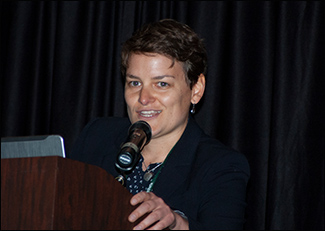Reducing Methane Emissions and Improving Feed Efficiency
 Ranchers can benefit from using technological and nutritional approaches to reducing methane emissions.
Ranchers can benefit from using technological and nutritional approaches to reducing methane emissions.
by Megan Silveira, editorial intern
LOVELAND, Colo., June 21, 2018 — Things got a little gassy at the Beef Improvement Federation Research Symposium and Convention in Loveland, Colo. Sara Place, director of sustainable beef production research at the National Cattlemen’s Beef Association spoke to ranchers about lowering methane emissions in her talk, “Technology and Nutritional Approaches to Mitigating Enteric Methane.”

Sara Place, director of sustainable beef production research at the National Cattlemen’s Beef Association.
Place said consumers have recently been pressing beef producers to focus on sustainability. Consumers are demanding cattlemen better manage the amount of methane emitted, despite beef cattle being responsible for only 1.86% of total methane emissions in the United States, Place said.
Methane emissions are a biological aspect of the ruminant digestive system, Place explained. “As cattle eat more, they naturally release more methane.”
Place said there are more benefits to lowering the methane emissions of cattle than just pleasing consumers. If emissions are lowered, fermentation will become more efficient. Methane emissions release digestible energy, with the potential to be used for other bodily functions, into the atmosphere, where Place said it essentially becomes wasted energy.
“If we’re lowering these emissions, we should hopefully be seeing cattle be more efficient,” Place said.
If ranchers are ready to create more efficient and productive cattle, Place said there are a few options they can pursue. Dietary methods that help reduce methane emissions include feeding dietary lipids or concentrate feeding. Place said this is a “classic choice,” and grain-finished cattle produce significantly lower levels of methane than forage-finished cattle. Several feed additives are also available to help lower methane emissions.
There are a handful of companies in the world Place identified as playing roles in mitigating the methane problem. Mootral is a company with an additive that will become commercially available within the next year that promises to lower methane emissions by 30%.
DSM is another company producing a methane inhibitor. While Place said this additive is not yet commercially available, it has proven to be a bright spot in the future of the cattle industry. Known as 3NOP, this inhibitor works by stopping enzymes in the metabolic pathway.
In research where cattle were given a 3NOP dose of 200 milligrams per kilogram, Place said the product was able to decrease the amount of methane emitted. In a follow-up study, animals given the additive exhibited better feed-to-gain ratios.
While Place said a lot more research needs to be conducted on this product and methane emissions in general, ranchers have been given a reason to think positively about the future of the cattle industry.
Editor’s Note: The articles used within this site represent a mixture of copyrights. If you would like to reprint or repost an article, you must first request permission of Angus Media by contacting the editor at 816-383-5200; 3201 Frederick Ave., Saint Joseph, MO 64506. Angus Media claims copyright to this web site as presented. We welcome educational venues and cattlemen to link to this site as a service to their audience.


